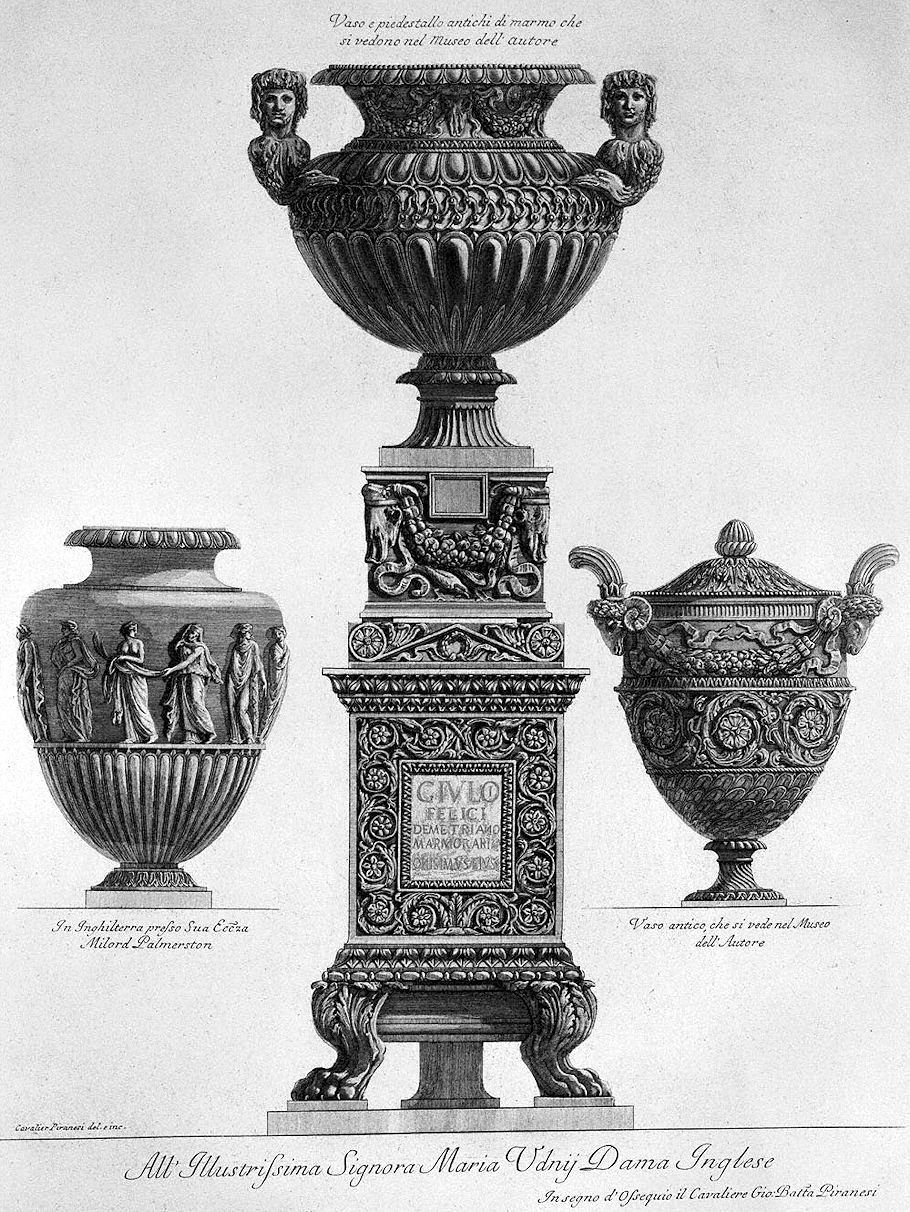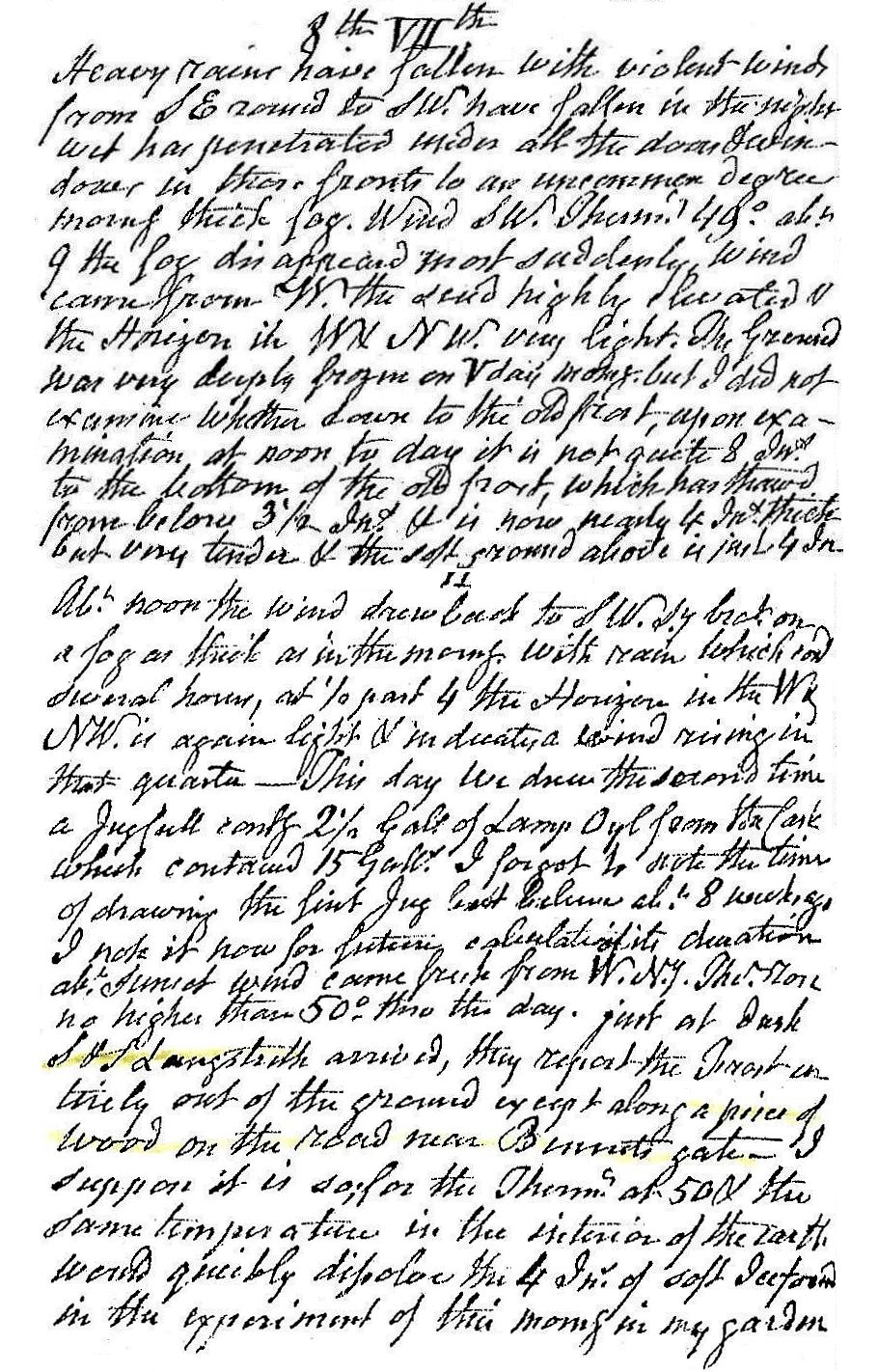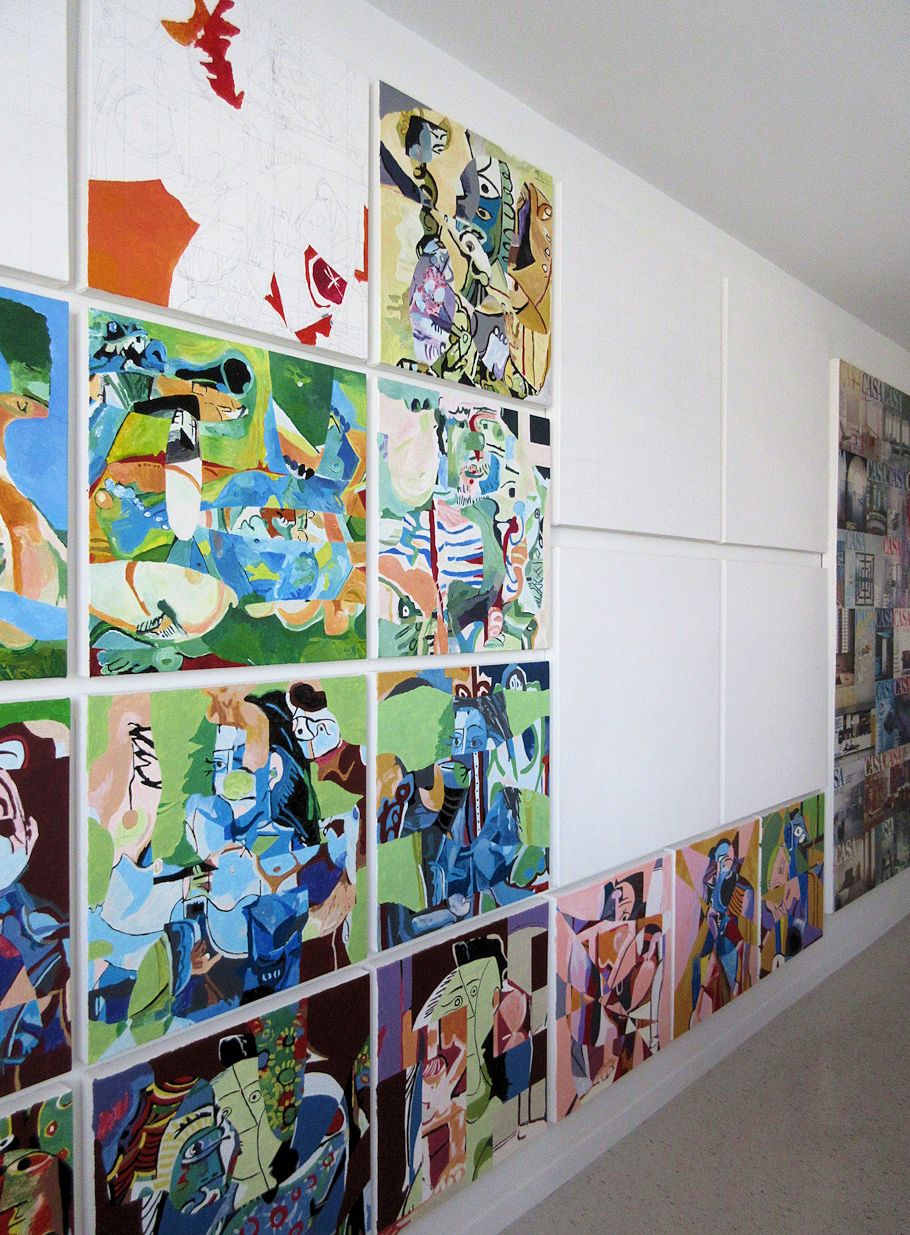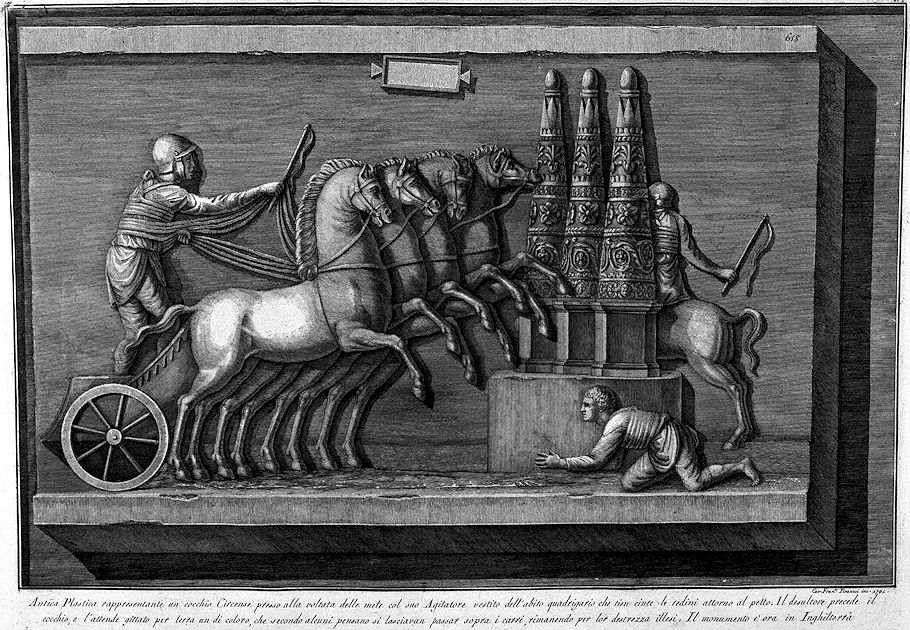8 February 1778 Sunday
Vases, Candelabra, Grave Stones, Sarcophagi. Tripods, Lamps and Ancient Ornaments volume I

To the Most Illustrious Lady Maria Udnij English Dame
As a sign of respect, Cavaliere Gio: Batt(ist)a Piranesi
Antique marble vase and pedestal seen in the Author's Museum
In England at Her Excellency Milord Palmerston
Ancient vase, which can be seen in the author's museum
Cavalier Piranesi del. e inc
8 February 1812 Saturday

Heavy rains have fallen with violent wind from SE round to SW have fallen in the night. Wet has penetrated inside[?] all the doors and windows in those fronts to an uncommon degree. Morning thick fog. Wind Sw. Therm, 49°. About 9 the fog disappeared most suddenly. Wind came from W. The .... highly elevated, and the horizon W and NW very light. The ground was very deeply frozen on Thursday morning, but I did not examine whether down to the old frost. Upon examination at noon today it is not quite 8 inches to the bottom of the old frost, which has thawed from below 3 1/2 inches and is now almost 4 inches thick but very tender and the soft ground above is just 4 inched. About noon the wind drew back to SWSerly, brought on a fog as thick as in the morning, with rain which continued several hours. At 1/2 past 4 the horizon in the W and NW is again light and indicated a wind rising in that quarter.
This day we drew a second time a jug full containing 2 1/2 gallons of lamp oil from the cask which contained 15 gallons. I forgot to note the time of drawing the first jug but believe about 8 weeks ago. I note it now for future calibration of its duration. About sunset wind came fresh from NWerly. Therm. rose no higher than 50° thru the day. Just at dusk S. and S. Longstreth arrived, They report the frost entirely except along a piece of wood on the road near Bennets gate. I suppose it is so, for the therm. at 50 and the same temperature in the interior of the earth would quickly dissolve the 4 inches of soft ice found in the experiment of this morning in my garden.
8 February 1998
Aldo Rossi and the Axis of Death
...a reference to Rossi's own death in September 1997. ...demonstrate the effect of the Bustum Hadriani on Rossi's Modena Cemetery design. ...finding [Rossi's design] on the Axis of Death.
Piranesi and the Ichnographia are never mentioned within The Architecture of the City or The Scientific Autobiography even though the autobiography is all about personal inspirations.
In reading the article in Oppositions 5, (Rafael Moneo, "Aldo Rossi: The Idea of Architecture and the Modena Cemetery") there are some descriptions of Rossi's notions of the city that also describe the Ichnographia:
These elements are intelligible through memory, not through remembering. This kind of extreme analytic suspension gives us a fleeting glimpse of the raison d'ętre of the city.
But the wish to clarify, to order the elements with which the city is constructed, leads Rossi to present "the fundamental hypothesis of the book . . . the study of a typology of buildings in relation to the city."
However, before proceeding, it is necessary to recall the architectonic category of permanence which Rossi associates with memory. There are, in the city, urban facts which are permanent, that withstand the passage of time; these urban facts are the monuments that, in one way or another, constitute or make up and configure the city. The monument therefore has more than an intelligible and atmospheric value, it is not only architecture as anecdote, as the picturesque, but it gives meaning to the life of the city which, through these monuments, both remembers the past and uses 'its memory.'
This collective nature explains the value of history: "the city is a repository of history."
The city is faithful to its own "memory," a term the Maurice Halbwachs already applied to the city. "The city is the locus of collective memory. Memory this becomes . . . the conducting thread of the entire complex structure . . . the collective nature and the individuality of urban facts arrange themselves into the same urban structure. Within this structure memory becomes the conscience of the city.
8 February 2001
control
In commenting on Nunn's "Designing the Solipsistic City", Rick says/asks, "There is not much wrong in what Prof. Nunn says above, but is it not fairly obvious? Doesn't everyone know that preachers, cops and planners are control freaks? I'm surprised he doesn't cite Thomas Crapper for his ambitions to control defecation by bringing it indoors.
But then, is that not a rather built-in attitude we carry around--this problem of control--since at least the Renaissance?"
Another way of viewing the issue of planning/design via control is to see it as a metabolic activity, meaning, rather than just control being employed, what is really going on is that something is being destroyed in the guise of something being created.
This metabolic 'imagination' (in Western history) appears much earlier than the Renaissance, however. A careful study of the Roman Empire during the 4th century AD reveals a very systematic 'destruction' of Paganism in the guise of 'creating' Christianity. Is it just coincidence that the feast of St. Helena on 18 August is also the date of the Rape of the Sabine Women? Or that the dual feast of St. Constantine and St. Helena (son and mother) on 21 May is also the date of the second Agonalia, one of two feasts in honor of the 'two-faced' god Janus? Or that the first feast of the Agonalia on 9 January is in the Christian calendar likewise the feast of dual martyrs, the 'perpetually chaste' husband and wife Sts. Julian and Basilissa, who although today are doubted to have actually existed nonetheless bear some resemblance to Constantine and Helena and even more so to Christ and Mary? Or that Santa Croce in Gerusalemme, one of Rome's top seven churches and the continuation of the chapel that St. Helena built in her Roman home (the Sessorian Palace) which contains ground/dirt from Calvary which Helena brought back from the Holy Land, was dedicated on 20 March which was Pagan Rome's day of blood?
It still seems necessary to point out that as of 28 October 312 Christianity was imperially sanctioned within the western half of the Roman Empire. That as of 324, when Constantine became sole ruler of the whole Empire, that then too Christianity was imperially sanctioned throughout the whole Empire. And that in 380, under the rule of the emperor Theodosius, Christianity then became the Roman Empire's official and sole religion, hence at the same time officially ending all Paganism throughout the empire.
Interestingly, the first 'barbarian' invasion of the city of Rome circa 400 caused the subsequent resurgence of Paganism in Rome since the promised wonders of Christianity did not transpire in Rome, rather their seeming exact opposite. Also interestingly, those first barbarian attackers were actually Christians! This new rise of Paganism is what prompted St. Augustine to write The City of God Against the Pagans. Yes, this is the same book more commonly known as simply The City of God, although its full title is much more to the point. So, getting back to modern planning and 'control', perhaps it's all just a reenactment of what a bishop from North Africa published almost 1600 years ago.
more on (metabolic) control
The following is from Butler's Lives of the Saints January 24, St. Babylas, Bishop of Antioch, Martyr (c. A.D. 250):
The most celebrated of the ancient bishops of Antioch after St. Ignatius was St. Babylas, who succeeded Zebinus about the year 240, but regrettably little is known about him. According to St. John Chrysostom he was the bishop who, Eusebius reports, refused admittance to the church on Easter day in 244 to Philip the Arabian--alleged to be a Christian--till he had done penance for the murder of his predecessor the Emperor Gordian. St. Babylas died a martyr during the persecution of Decius, probably in prison as Eusebius says, but Chrysostom states he was beheaded.
St. Babylas is the first martyr of whom a translation of relics is recorded. His body was buried at Antioch; but in 351 the caesar Gallus removed it to a church at Daphne a few miles away to counteract the influence there of a famous shrine of Apollo, where oracles were given and the licentiousness was notorious. The oracles were indeed silenced, and in 362 Julian the Apostate [the mid-4th century Roman Emperor that renounced Christianity and briefly revived imperial Paganism even though he was the son of one of Constantine's half brothers and was married to Constantine's youngest daughter Helena, namesake of you know who!] ordered the relics of the martyr be removed. Accordingly they were taken back to their former resting-place, the Christians accompanying them in procession, singing the psalms that speak of the powerlessness of idols and false gods. The following evening, we are told, the temple of Apollo was destroyed by lightening [how 'naturally' convenient!]. A little later there was a third translation, made by the bishop St. Meletius, to a basilica he built across the Orontes; Meletius himself was buried next to St. Babylas.
[The bracketed comments are my insertions.]
It was with the death of Julian the Apostate during the night of 26 June 363 that the (thoroughly metabolic) Constantinian dynasty ended. Constantine first came to (an imperial level of) power 25 July 306.
8 February 2017

8 February 2023 Wednesday
Vases, Candelabra, Grave Stones, Sarcophagi. Tripods, Lamps and Ancient Ornaments volume II

Ancient Plastic depicting a circus chariot near the vault of the goals with its Agitator dressed in the quadrigary suit who holds the reins around his chest. The desultor precedes the chariot, and awaits him thrown to the ground one of those who, according to some think, allowed themselves to pass over the chariots, remaining unharmed due to their dexterity. The monument is now in England.
Cav. Fran.co Piranesi inc. 1791.
|